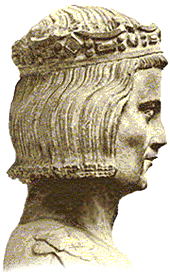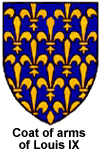...Best of Sicily presents... Best of Sicily Magazine. ... Dedicated to Sicilian art, culture, history, people, places and all things Sicilian. |
by Vincenzo Salerno | ||
Magazine Index Best of Sicily Arts & Culture Fashion Food & Wine History & Society About Us Travel Faqs Contact Map of Sicily |
Though Louis was known for his religious piety, he also took an active part in the crusading movement, usually (except for Frederick's pacific Sixth Crusade) advocating war against the Muslims. He was a patron of the arts, particularly favorable to the Gothic architectural movement, and known (when not fighting) as a kindly and generous man. For the Capetians crusading was a family tradition. Philip II, grandfather of Louis, found himself in Messina in 1190 with Richard Lionheart en route to Palestine on the Third Crusade. Louis actually ended the infamous Albigensian Crusade in 1229 by reaching an accord with Count Raymond VII of Toulouse. The Seventh Crusade (to Egypt in 1248) and the Eighth Crusade (reaching Tunisia in 1270) were military failures. Louis was taken prisoner during the first one and fell ill during the second. He found himself in Sicily on several occcasions, though he probably did not imagine that his heart would end up here. The French troops were ill-prepared for conditions in Tunisia, and many died of dysentery. On 25 August 1270 Louis himself died. This is his feast day; he was canonised in 1297. In his own age, he epitomised Christendom's ideal monarch, but the same could not be said of his brother, whose Sicilian nobles overthrew his authority in 1282 during the Vespers uprising (though Charles retained mainland Italy). The corpse of King Louis IX was taken to Sicily en route to France, and
his heart is Louis was succeeded by his son, Philip III, whose wife, Isabella of Aragon, died in January 1271 when she fell off a house while fording a stream near Cosenza, in Calabria, during the family's return to France. Her son, Philip (IV), later became King of France. Sicily remained a peripheral part of the French dynasty's adventures for some years. Philip III was less astute politically than his "saintly" father, and perhaps too easily influenced by his unsaintly uncle Charles of Naples. He died in 1285 returning from a failed attempt to conquer Aragon for Charles, who resented King Peter of Aragon for accepting the Sicilian crown following the Vespers uprising. Saint Louis is the patron of France. The fleur de lis strongly identified with Louis and his dynasty appears, appropriately, as a motif on the exterior of Monreale Abbey. Decades earlier, the golden fleur de lis on a dark blue (azure) field was chosen to represent the Norman kings of Sicily, appearing on the robe of of Roger II depicted in mosaic in the Martorana church in Palermo. Louis IX knew Sicily during its Swabian and Angevin periods. Luigi began to be used as a given (Christian) name in Sicily in the fourteenth century. About the Author: Palermo native Vincenzo Salerno has written biographies of several famous Sicilians, including Frederick II and Giuseppe di Lampedusa. | |
Top of Page |
 Born in 1214, Louis IX of Anjou was king of France from 1226 until his death in 1270. He was a contemporary of
Born in 1214, Louis IX of Anjou was king of France from 1226 until his death in 1270. He was a contemporary of  preserved at
preserved at